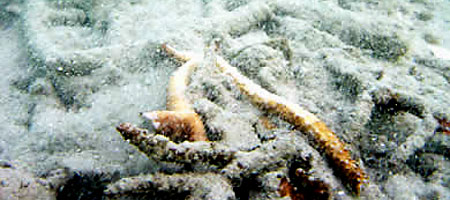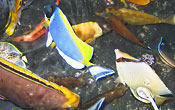
Most of tsunamiís damage was caused by the shifting of coral rubble from Sri
Lankaís 1998ís bleaching.-IUCN
Breakwater or breakdown?
GEA SWEE JEAN
When the tsunami's waves pummeled Sri Lanka's coastline more than a year ago, little did we know that the coast had one natural barrier standing guard - the coral reefs.
After the tsunami it was reported that in places where the reefs were healthy, the land and its people suffered less, as the reefs bolstered the impact.
More than a year later, Sri Lanka has to cope with a slow but sure degradation of the natural resource that has been the main provider of the country's coastal communities for several decades.
Fishing, collection of ornamental fish and sea cucumbers for export, coral mining - these are the core activities that livelihoods in its coastal communities have been built around for decades.
But does the country have what it takes to strike the delicate balance between saving its natural resource, and maintaining these livelihoods, in these fragile post-tsunami days?
A bad record
To be sure, the reefs were unhealthy even before the tsunami.
Sri Lanka's history of coral reef damage is not pretty, to say the least. Its reefs have been under severe pressure for the past three or four decades for a number of reasons.
The worst cause of damage is coral mining. This practice has been banned since 1983 but still persists today.
Another major problem is destructive fishing practices such as blast fishing, and the use of bottom-set nets and moxy-nets. These methods not only deplete fish stock at an alarming rate, but also destroy fish habitat.
Uncontrolled harvesting also contributes to the reefs' breakdown. Among the commonly harvested species are sea cucumbers, chanks, lobsters, as well as edible and ornamental fish.
Yet the reef damage is not all man-made.
In 1998 the worst case of coral bleaching occurred in the waters around Sri Lanka.
Coral bleaching is a natural phenomenon caused by abnormally high water temperatures, which "bleach" the colours out of corals, leaving them white.
In 1998, changes in Indian Ocean currents caused the rise in temperature, killing anywhere from 50% to 98% of the country's corals, and greatly weakening those that survived.
And in December 2004, the tsunami hit.
Rapid assessment
Findings from a rapid assessment of tsunami damage to coral reefs carried out in January last year revealed that damage was "highly varied" - some reefs were almost totally unaffected, while others were extremely damaged.
next »
